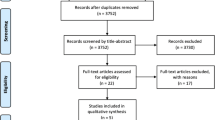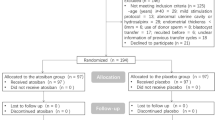Abstract
Objectives
Evidence for the efficacy of atosiban in improving pregnancy outcomes among patients undergoing assisted reproductive technology (ART) remains inconsistent.
Methods
The PubMed, EMBASE, and CNKI databases were searched using keywords such as ‘atosiban’, ‘infertility’, and ‘ART’. Studies that explored the efficacy of atosiban in the field of ART for patients with embryo transfer (ET) were included if they evaluated pregnancy outcomes. Combing using subgroups and sensitivity analysis were conducted, and risk ratios (RRs), and 95% confidence intervals (CIs) were calculated.
Results
Six studies were included. Atosiban treatment could improve pregnancy outcomes for all patients undergoing ET, especially for the subgroups of patients with repeated implantation failure (RIF) (implantation rate: RR = 1.806, 95% CI = 1.473–2.215; clinical pregnancy rate: RR = 1.725, 95% CI = 1.394–2.135; live birth rate: RR = 2.141, 95% CI = 1.494–3.068), as shown by the comparison with placebo or no-treatment groups. However, no statistical significance was detected in subgroups of patients undergoing their first or second ET cycle. In addition, no significant differences were observed in positive pregnancy tests, miscarriage rates, multiple pregnancy rates, or ectopic pregnancy rates.
Conclusions
Supplementation with atosiban has a positive effect on ART and embryo transfer procedure, especially for women undergoing their third or more ET cycle.




Similar content being viewed by others
References
HFEA fertility treatment in 2010: trends and figures. http://www.hfea.gov.uk/6771.html. Accessed 11 Dec 2011
Canadian ART Register (CARTR) latest annual figures. http://www.cfas.ca/index.php?option=com_content&view=article&id=1129%. Accessed 11 Dec 2011
Ferraretti AP, Goossens V, Kupka M, Bhattacharya S, de Mouzon J, Castilla JA, Erb K, Korsak V, Nyboe Andersen A, European IVF-Monitoring (EIM) Consortium for the European Society of Human Reproduction and Embryology (ESHRE). Assisted reproductive technology in Europe (2013) Assisted reproductive technology in Europe, 2009: results generated from European registers by ESHRE. Hum Reprod 28:2318–2331
Diaz-Gimeno P, Horcajadas JA, Martinez-Conejero JA, Esteban FJ, Alamá P, Pellicer A, Simón C (2011) A genomic diagnostic tool for human endometrial receptivity based on the transcriptomic signature. Fertil Steril 95:50–60 (60.e1–15)
Pierzynski P, Reinheimer TM, Kuczynski W (2007) Oxytocin antagonists may improve infertility treatment. Fertil Steril 88(213):e19–e22
Ayoubi JM, Epiney M, Brioschi PA, Fanchin R, Chardonnens D, de Ziegler D (2003) Comparison of changes in uterine contraction frequency after ovulation in the menstrual cycle and in vitro fertilization cycles. Fertil Steril 79:1101–1105
Akhtar MA, Netherton R, Majumder K, Edi-Osagie E, Sajjad Y (2015) Methods employed to overcome difficult embryo transfer during assisted reproduction treatment. Arch Gynecol Obstet 292:255–262
Mesen TB, Kacemi-Bourhim L, Marshburn PB, Usadi RS, Matthews M, Norton HJ, Hurst BS (2013) The effect of ketorolac on pregnancy rates when used immediately after oocyte retrieval. Fertil Steril 100:725–728
Steinwall M, Bossmar T, Brouard R, Laudanski T, Olofsson P, Urban R, Wolff K, Le-Fur G, Akerlund M (2005) The effect of relcovaptan (SR 49059), an orally active vasopressin V1a receptor antagonist, on uterine contractions in preterm labor. Gynecol Endocrinol 20:104–109
Chou PY, Wu MH, Pan HA, Hung KH, Chang FM (2011) Use of an oxytocin antagonist in in vitro fertilization-embryo transfer for women with repeated implantation failure: a retrospective study. Taiwan J Obstet Gynecol 50:136–140
Moraloglu O, Tonguc E, Var T, Zeyrek T, Batioglu S (2010) Treatment with oxytocin antagonists before embryo transfer may increase implantation rates after IVF. Reprod Biomed Online 21:338–343
Decleer W, Osmanagaoglu K, Devroey P (2012) The role of oxytocin antagonists in repeated implantation-failure. Facts Views Vis Obgyn 4:227–229
Lan VT, Khang VN, Nhu GH, Tuong HM (2012) Atosiban improves implantation and pregnancy rates in patients with repeated implantation failure. Reprod Biomed Online 25:254–260
Ng EH, Li RH, Chen L, Lan VT, Tuong HM, Quan S (2014) A randomized double blind comparison of atosiban in patients undergoing IVF treatment. Hum Reprod 29:2687–2694
He Y, Wu H, He X, Xing Q, Zhou P, Cao Y, Wei Z (2016) Application of atosiban in frozen-thawed cycle patients with different times of embryo transfers. Gynecol Endocrinol 5:1–5
RoyChoudhury S, Singh A, Gupta NJ, Srivastava S, Joshi MV, Chakravarty B, Chaudhury K (2016) Repeated implantation failure versus repeated implantation success: discrimination at a metabolomic level. Hum Reprod 31:1265–1274
Bord I, Tamir B, Harlev A, Har-Vardi I, Lunenfeld E, Friger M, Levitas E (2016) Recurrent implantation failure in IVF: features of cycles that eventually ended in conception. Arch Gynecol Obstet 293:893–900
Blettner M, Sauerbrei W, Schlehofer B, Scheuchenpflug T, Friedenreich C (1999) Traditional reviews, meta-analyses and pooled analyses in epidemiology. Int J Epidemiol 28:1–9
Higgins JP, Thompson SG, Deeks JJ, Altman DG (2003) Measuring inconsistency in meta-analyses. Br Med J 327:557–560
Egger M, Davey Smith G, Schneider M, Minder C (1997) Bias in meta -analysis detected by a simple, graphical test. BMJ 315:629–634
Zhang Y, Chu Y, Luo H, Zhang Y, Xue F (2014) Ifluence of atosiban on pregnancy outcomes in patients with repeated implantation failure in freezing embryo transfer cycle. Chin J Fam Plann 22(5):325–328
Chen C, Liu L, Li Y, Gao Y, Geng Y (2014) Oxytocin receptor antagonist atosiban in blastocyst thaw transplantation in clinical observation. Reprod Contracept 34(8):633–637
Winger EE, Reed JL, Ashoush S, El-Toukhy T, Ahuja S, Taranissi M (2011) Elevated preconception CD56+ 16+ and/or Th1:Th2 levels predict benefit from IVIG therapy in subfertile women undergoing IVF. Am J Reprod Immunol 66:394–403
Fanchin R, Ayoubi JM, Olivennes F, Righini C, de Ziegler D, Frydman R (2000) Hormonal influence on the uterine contractility during ovarian stimulation. Hum Reprod 15:90–100
Ijland MM, Evers JL, Dunselman GA, van Katwijk C, Lo CR, Hoogland HJ (1996) Endometrial wavelike movements during the menstrual cycle. Fertil Steril 65:746–749
Eskes TK, Hein PR, Stolte LA, Kars-Villanueva EB, Crone A, Braaksma JT, Janssens J (1970) Influence of dydrogesterone on the activity of the nonpregnant human uterus. Am J Obstet Gynecol 106:1235–1241
Johnston-MacAnanny EB, Hartnett J, Engmann LL, Nulsen JC, Sanders MM, Benadiva CA (2010) Chronic endometritis is a frequent finding in women with recurrent implantation failure after in vitro fertilization. Fertil Steril 93:437–441
Zhang Q, Zhang B, Yan J, Zhang C, Tang R, Sheng Y, Wang N, Chen ZJ (2015) Intracavitary physiotherapy is not inferior to endometrial scratching in patients with recurrent implantation failure. Arch Gynecol Obstet 291:173–177
Akerlund M, Melin P, Maggi M (1995) Potential use of oxytocin and vasopressin V1a antagonists in the treatment of preterm labour and primary dysmenorrhoea. Adv Exp Med Biol 395:595–600
Boivin J, Schmidt L (2005) Infertility-related stress in men and women predicts treatment outcome 1 year later. Fertil Steril 83:1745–1752
Sagi-Dain L, Ojha K, Bider D, Levron J, Zinchenko V, Walster S, Sagi S, Dirnfeld M (2017) Pregnancy outcomes in oocyte recipients with fibroids not impinging uterine cavity. Arch Gynecol Obstet 295:497–502
Penrod LV, Allen RE, Rhoads ML, Limesand SW, Arns MJ (2013) Oxytocin stimulated release of PGF2α and its inhibition by a cyclooxygenase inhibitor and an oxytocin receptor antagonist from equine endometrial cultures. Anim Reprod Sci 139:69–75
Vedernikov Y, Betancourt A, Shi S, Shi L, Reinheimer T, Garfield R (2006) Oxytocin antagonistic effect of barusiban and atosiban in isolated uterine artery from late pregnant rats. In: Presentation at the Annual Scientific Meeting of the Society for Gynecologic Investigation, 2006. Toronto, Canada
Pierzynski P, Gajda B, Smorag Z, Rasmussen AD, Kuczynski W (2007) Effect of atosiban on rabbit embryo development and human sperm motility. Fertil Steril 87:1147–1152
De Heus R, Mulder EJ, Derks JB, Visser GH (2008) Acute tocolysis for uterine activity reduction in term labor: a review. Obstet Gynecol Surv 63:383–388
Vanakara P, Dafopoulos K, Papastergiopoulou L, Kallitsaris A, Papageorgiou I, Messinis IE (2007) Oxytocin is not important for the control of gonadotrophin secretion in the late follicular phase of the cycle. Clin Endocrinol (Oxf) 66:816–821
Author information
Authors and Affiliations
Contributions
JL, YC, and HYZ conceived and designed the study. JL, ARW, and YC analyzed the data. HYZ and JL wrote the “Introduction” and “Discussion”. JL, ARW, and YC wrote the “Materials and methods” and “Results”. HYZ, ARW, and YC provided significant advice for the manuscript. JL, HYZ, and ARW were mainly responsible to write and modify the draft.
Corresponding authors
Ethics declarations
Funding
There is no funding.
Conflict of interest
Authors (J.L., Y.C., AR. W., and HY. Z.) declare that they have no conflict of interest.
Ethical approval
This article does not contain any studies with human participants or animals performed by any of the authors.
Rights and permissions
About this article
Cite this article
Li, J., Chen, Y., Wang, A. et al. A meta-analysis of atosiban supplementation among patients undergoing assisted reproduction. Arch Gynecol Obstet 296, 623–634 (2017). https://doi.org/10.1007/s00404-017-4455-0
Received:
Accepted:
Published:
Issue Date:
DOI: https://doi.org/10.1007/s00404-017-4455-0




